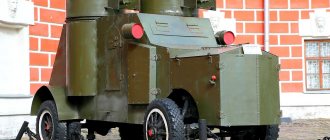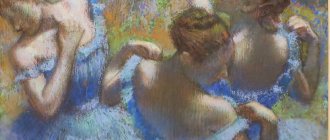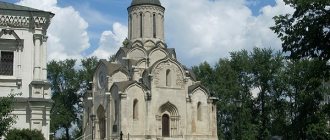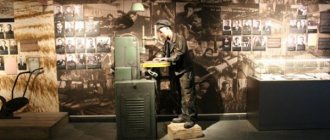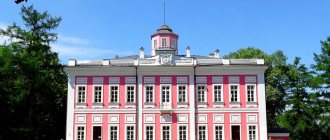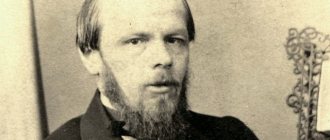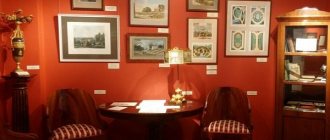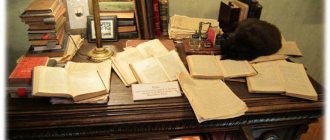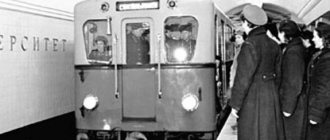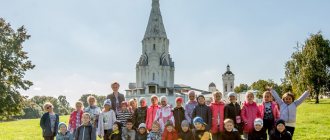The Museum of Estates in Moscow is one of the youngest museums in Moscow, opening in 2021. In the Museum of Estates you can see costumes, household items from different regions of Russia, and listen to interesting facts about the pre-revolutionary life of nobles, peasants and clergy. But there are some nuances when visiting the museum, which I will talk about in the review.
Museum of the Estates of Russia in Moscow, nobility hall
Within walking distance from the Kropotkinskaya metro station, opposite the Pushkin Museum. Pushkin is the Ilya Glazunov Gallery. This restored mansion building, which once belonged to the Naryshkin family, is impossible not to notice. Paintings painted by the famous Soviet artist are exhibited here. But few people will immediately see the dark pink building attached to the mansion, since it is “hidden” behind another building. Meanwhile, this house houses a new museum, opened on June 12, 2021 - the Museum of Estates.
The Museum building is a modern structure, stylized as a noble mansion of the 19th century. It was designed personally by Ilya Glazunov. The artist planned to place here an extensive collection of household items from representatives of the classes of the Russian Empire, which he collected throughout his life.
Construction took a long and painful time. The completion date of the work was postponed several times. Finally, on June 12, 2021, on Russia Day, the grand opening took place, and literally a month later Ilya Sergeevich died.
The museum is located on Volkhonka Street. To get there you need to walk along the Ilya Glazunov Gallery and turn right into the courtyard. It would seem that everything is simple, but people cannot find their way. I myself saw how one company entered the Gallery building and asked how to get to the Museum of Estates.
By the way, from Volkhonka there is an interesting view of the monument to Prince Vladimir, and from the courtyard of the museum - of the Cathedral of Christ the Savior, but it was not possible to photograph them well, since the weather was cloudy and raining, and I don’t like taking photographs in such conditions, so I took a couple of shots and quickly went into the room.
Volkhonka, Moscow
View of the Cathedral of Christ the Savior
Everything inside the museum is strict. At the entrance you are greeted by a security guard responsible for screening visitors and one of the caretakers. Shoe covers must be put on at the entrance, even before you walk through the frame.
Tour of the Estates Museum: only with a tour group
Visiting the museum is only possible as part of a tour group, which should not exceed 15 people. Tours run every hour. If you come and there are already 15 people, you will have to wait outside. They say that this was the desire of Glazunov himself, who did not want crowds walking around the premises who just came here on the way. I was lucky to get to the museum as part of an organized group. By the way, this idea is not a bad one, if only because on the first floor almost all the halls are blocked off and you can only walk along a narrow passage, and on the second and third there is a danger of “demolishing” some rare exhibit, and the staircase between the floors is narrow and It is not designed for oncoming flows of tourists.
Why is the Museum of Russian Estates interesting?
The Museum of Estates is a collection of a large number of genuine rare things that Ilya Sergeevich acquired throughout his life: he bought, selected, found, asked for when he was on any trips around the country or abroad. The artist restored all the items on his own. The collection does not have a narrow specificity, for example, only icons, flags, paintings. Ilya Sergeevich tried to preserve everything that had to do with pre-revolutionary Russia. Some items, such as spinning wheels, are presented in several copies. Such a number of objects really needs a separate large room to house it, but I would not call it the Museum of the Estates. The excursion does not tell about the classes of the Russian Empire, nor about the history of the creation of the collection, nor about the biography of I.S. Glazunov.
The exhibits are distributed over three floors, in accordance with the three classes: the first - the nobility, the second - the clergy and the third - the peasantry. The question immediately arises why this is so, because there were more classes, however, this was the decision of the founder of the museum himself.
Museum of the Estates of Russia in Moscow, nobility hall
First floor of the museum: nobility
The floor dedicated to the nobility is decorated in the style of nineteenth-century mansions. There are a lot of paintings and furniture here. The walls of some rooms are decorated with fabric woven according to samples that have come down to us. In addition to decorative items and furniture, various costumes are presented here. The interesting thing is that they are not displayed in shop windows, but are presented on mannequins. Moreover, these are not just impersonal mannequins from a store, but with hairstyles and makeup; with clear facial features. Because of this, you get the impression that you are passing by frozen people.
Museum of the Estates of Russia in Moscow, hall of nobility, mannequins
Museum of the Estates of Russia in Moscow, corridors
To our great surprise, almost all rooms were prohibited from access. That is, you can only look at the exhibits from the corridor, and you cannot come closer to look at a painting or piece of furniture. True, it should be noted that time is not given for such a detailed inspection, but more on that later.
Museum of the Estates of Russia on Volkhonka
Second floor of the Museum of Estates of Russia: clergy
In the “Clergy” exhibition you can find rare icons, including those painted before Nikon’s reform. The painting of the walls of the halls on this floor is reminiscent of the interior decoration of ancient Orthodox churches.
Museum of Estates
Museum of Estates, Clergy
On this floor there is also a hall where ceremonial portraits of emperors are located. It is very beautiful in here.
Museum of the Estates of Russia in Moscow, ceiling
Museum of the Estates of Russia in Moscow
Museum of the Estates of Russia in Moscow
There is also a hall made in the style of the chambers of Alexei Mikhailovich Romanov. I really liked the ceiling painting here. The guide pointed out the carved window sill, made by modern craftsmen, as the main attraction of this small room.
Museum of the Estates of Russia in Moscow
Museum of the Estates of Russia in Moscow, carved window sill
Museum of the Estates of Russia in Moscow, double-headed eagle
“Museum of Estates” opened in Moscow
“During the work that has been carried out since January 2008, a three-story mansion with a ground and basement floor in the Moscow Empire style was erected next to the main building of the gallery,” said the head of the department, Sergei Levkin. The building is equipped with a modern engineering and technical complex, including microclimatic equipment, cassette parking, a gas fire extinguishing system, an elevator for people with disabilities, restoration workshops (painting, graphics), a photo laboratory and a cafe. It has several entrances.
The total area of the reconstructed facility is more than 5 thousand square meters. m, at the level of the second floor, the new museum and the existing gallery are connected by an overhead passage. When carrying out finishing work in the museum, the technologies of the old masters were used. Particular attention was paid to the interior decoration of the estate: artistic painting of ceilings, walls and domes, carved oak window sills, stained glass windows, plaster door portals, gilded cornices, drapery of windows and walls with fabric according to ancient samples. Such attention to detail will allow museum exhibits to be organically placed in the exhibition.
Currently, the “Museum of Estates of Russia” is beginning the formation and installation of exhibition halls, where an expanded exhibition of works of Russian and Western European art from the collection of S. Glazunov will be presented.
According to the museum:
The 1st floor will be dedicated to the Culture of noble Russia of the 18th - early 20th centuries.
A suite of noble interiors, decorated in a classical style, a Music Hall (with 180 seats), a Library (rare old books), and an Engraving Room. Works of art of the nobility: paintings by Western European and Russian artists, engravings, ancient books, furniture, ancient Russian fabrics, tapestries, artistic bronze (sculptures, clocks, chandeliers, candelabra), works of porcelain and glass, costume, etc.
The 2nd floor will give a description of the art of Orthodox Rus'.
Icons, copper-cast icons, crosses, folding pieces, works of decorative and applied art (enamel icons, sewing, tiles, reliefs), Russian-style furniture, made according to sketches by the artist V.M. Vasnetsova.
The 3rd floor will demonstrate the art, crafts, customs, and everyday life of peasant Russia.
Decorative and applied arts: hut furniture (parochial table, stove, benches with a crossbar, storage cabinets, fence cabinets); peasant household items (painted sleighs and arcs, chests and caskets, samovars, jars, pots, scoops, spoons, lights (plug-in, tabletop, floor), rolling pins and rollers, rubles, etc.); attributes of various crafts: spinning wheels - carvings and paintings from different provinces, spindles, loom, birch bark products; Russian artistic crafts (Khokhloma, Zhostovo, Gzhel, tile work, Dymkovo toys, Rostov enamel, niello, expanded iron, “frost on tin,” lacquer miniatures (Palekh, Mstera, Kholuy, Fedoskino), etc.); folk costumes of different provinces of Russia, popular prints.
The artistic director and author of the project, interiors and concept of the Museum of Estates is People's Artist of the USSR, academician Ilya Sergeevich Glazunov.
The museum plans to welcome its first visitors at the end of this year.
Third floor of the Museum of Estates of Russia: peasant life
And finally, the third floor, dedicated to peasant life. There are a lot of spinning wheels, scarves, chests...
Museum of Russian Estates in Moscow, peasantry
Museum of Russian Estates in Moscow, peasantry, scarves
Museum of Russian Estates in Moscow, peasantry, chests
There is a hall on the floor, the very last one, which I called “the hall of friendship of peoples.” There are a large number of mannequins in national costumes of 20 provinces of the Russian Empire. But they are dressed carelessly and without respecting historical truth. For example, married women’s hair should be completely removed, while mannequins’ headdresses should simply be neatly “placed” on their hair.
Museum of the Estates of Russia in Moscow, costumes from different provinces
Museum of Russian Estates in Moscow, costumes from different provinces 2
Our tour ended in this room, but we were not given independent time, but were escorted “under escort” to the cloakroom. In general, this museum has very interesting visiting rules. In addition to the fact that, as I already mentioned, you can only be on the territory in a group of no more than 15 people, and that on the ground floor access to a more detailed examination of the exhibits is closed, you are only allowed to move around with a guide. You cannot linger in one hall and you cannot go to the next one unless the guide invites you there. This is closely monitored by the wardens, who kick you out of the hall or do not let you out of it, standing in the doorway.
Museum of Russian Estates in Moscow, peasantry
The tour goes very quickly. There is clearly not enough time for such a volume. The guide recites a memorized short text about some of the exhibits. You can ask questions, but the guide has almost no time to answer them. There is also no opportunity to see anything on your own after the excursion. Everyone must leave before the next group.
During the tour you need to choose, either listen to the guide, or walk around the hall to see more, or choose the angle for the best photo. By the way, regarding photography. It is allowed without a flash, but many devices have an autofocus illuminator that works in dark rooms, and in our group many were pulled over for allegedly using a flash. We can say that the caretakers are my main impression of the museum. I have never seen such strict ones anywhere before.
Overall, I liked the museum. A must visit. You just need to come prepared so that you already know about the history of the estates, about Nikon’s reform, about I.S. Glazunov himself.
MuseumMuseum of Estates of Russia
On June 12, on Russia Day and on the occasion of the 87th anniversary of the People's Artist of the USSR Ilya Sergeevich Glazunov, the Ilya Glazunov Art Gallery opened a new exhibition - the Museum of Estates of Russia. As well as his works of painting and graphics (more than 700 works exhibited at Volkhonka, 13) I.S. Glazunov donated his personal collection to the city of Moscow, which was collected throughout the artist’s life, starting from his student years. Ilya Sergeevich Glazunov is the author of the idea, architectural design, interiors and exhibition of the museum, which, according to the creator’s plan, reflected the beauty of life and culture of class Russia.
Publicist and philosopher M.O. Menshikov wrote: “Estates are divisions based on labor... Estates were labor professions, corporations of very real, necessary labor. The nobility was a body of people's defense, a governing body. It really fought. Born for war, it often died in war. The clergy really controlled the spirit of the people; proof is the deep religiosity of the time and respect for the priesthood. The merchants traded and were not interested in anything else, artisans were engaged in crafts, farmers were engaged in agriculture... This order of things made it possible for a wonderful civilization to flourish...” The world of this “wonderful civilization” will come to life on three floors of the Museum of Estates of Russia. The viewer will consistently become acquainted with the peculiarities of culture, way of life, worldview of the nobles, clergy, peasantry and merchants.
The first floor of the museum is dedicated to the culture of noble Russia in the 18th - early 20th centuries. It reproduces the way of life of the nobility in the classical interiors of manor enfilades, furnished with antique furniture, works of painting and artistic bronze, engravings, and examples of pan-European fashion of that time. The second floor, the interiors of which are inspired by the decoration of the chambers of Tsar Alexei Mikhailovich, characterizes the art of Orthodox Rus'. Here the viewer will see works of icon painting and wooden temple sculpture, crosses, and folding sculptures. The crafts, customs and everyday life of peasant Russia are reflected on the third floor of the museum in the decoration of the hut, painted sleighs and arches, chests and caskets, samovars, spinning wheels and folk costumes of different provinces of Russia.
It should be noted that each class of Russia from the priesthood, aristocracy to the merchants and Russian peasantry had its own concept of the beauty of everyday life. In ancient Rus', princes and common people wore suits of similar cut, differing only in the richness of the fabric and decoration. As you know, Peter I banned the wearing of Russian folk costume, replacing it with Central European fashion of the 18th century. The beauty of Russian folk costume, as well as the beauty of household items, retreated to our province and was preserved until the beginning of the 20th century in the peasant class. Each province of Russia had its own folk costume, from Arkhangelsk, Vologda to Kursk and Voronezh. The exhibition features folk costumes from more than 20 provinces.
Each item presented in the new exhibition of the Ilya Glazunov Art Gallery preserves history and connections with centuries-old folk traditions. The significance of the Museum of Russian Estates is that it carries a deep ideology of patriotism and love for the Motherland.
